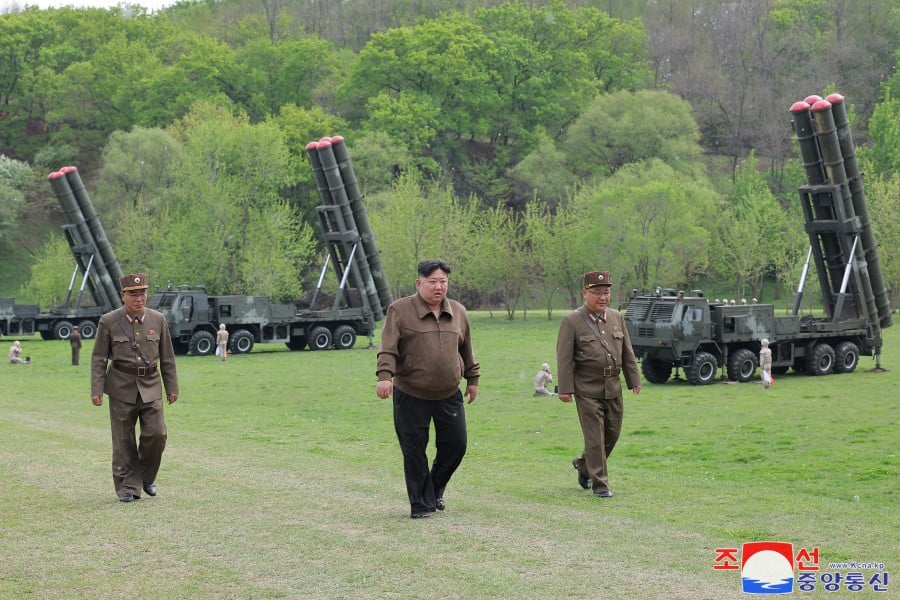
North Korea on Monday conducted a firing drill of short-range ballistic missiles (SRBMs), with state media Korean Central News Agency reporting that it was a firing of “super-large multiple rocket units” simulating a nuclear counterattack and marking the first use of its Haekbangashoe nuclear weapon combined management system.
The purpose of the North Korean drill, which was overseen by North Korean leader Kim Jong Un, was “to demonstrate the reliability, superiority, might and diverse means of the DPRK’s nuclear force and to strengthen the nuclear force both in quality and quantity as a clear warning signal to the enemies,” said KCNA.
KCNA went on to state that the U.S. and South Korea had been staging a combined joint formation drill at Kunsan Air Base since Apr. 12, and was “inciting war fever” by carrying out an average of 100 sorties a day. State media also claimed the drills, which end on Apr. 26, are aimed at North Korea, and that on Thursday, U.S and South Korean Special Operations Forces (SOF) staged a joint airborne infiltration drill for the purpose of rapidly infiltrating any region to remove a target.
A U.S. Air Force release on April 12 stated that personnel and aircraft of the U.S. Army, U.S. Air Force, U.S. Marine Corps and the Republic of Korea Air Force were carrying out the Korea Flying Training 2024 (KFT 24) exercise, which is part of the 7th Air Force’s annual training schedule.
“The event will highlight the ROK-U.S. Alliance by demonstrating lethality in the air domain, and enhancing its ability to deter, defend, and defeat any adversary,” read the release. A USAF release on Thursday’s parachute drop stated it was a routine event between the SOFs of the two countries.
KCNA reported that North Korea’s Monday drill assessed the reliability of the system of command, management, control and operation of the whole nuclear force under the Haekbangashoe system and ensured it had mastered the orders and combat methods to switch over to conduct a nuclear counterattack. A salvo firing was carried out with the rockets hitting an island target within a 352 km range. Photos released by KCNA showed four launch vehicles conducting a single salvo firing.

Kim said the drill served as an important occasion in thoroughly preparing North Korea’s nuclear force to rapidly and correctly carry out its mission of deterring a war and taking the initiative in a war or in any sudden situation, according to KCNA.
Earlier on Saturday, KCNA also reported that North Korea’s Missile Administration conducted a power test of a super-large warhead designed for Hwasal-1 Ra-3 strategic cruise missile and a test launch of the Pyoljji-1-2 new-type antiaircraft missile in the West Sea of Korea on Friday. “Both tests were part of the regular activities of the administration and its affiliated defence science institutes for the rapid development of technologies in various aspects such as tactical and technical performance and operation of new-type weapon systems, and had nothing to do with the surrounding situation,” reported KCNA.
On Monday, South Korea’s Joint Chiefs of Staff (JCS) stated that at 3:01 p.m. that day, the South Korean military tracked several projectiles believed to be SRBMs fired from the vicinity of the North Korean capital of Pyongyang towards the East Sea (Sea of Japan) that traveled 300 km before reaching the East Sea. The ROK military tracked and monitored the launches and shared the information with the U.S. and Japan. The JCS condemned the launch, saying it gravely threatens the peace and stability of the Korean Peninsula. “Our military will continue to closely monitor North Korea’s various activities and maintain the capability and readiness to overwhelmingly respond to any provocation under the strong U.S.-ROK joint defense posture,” read the statement.
U.S. Indo-Pacific Command issued a statement on Monday on the launch: “We are aware of the ballistic missile launch and are consulting closely with our allies and partners. … The U.S. commitment to the defense of the Republic of Korea and Japan remains ironclad.”
Japan’s Ministry of Defense on Monday stated that North Korea launched at least one ballistic missile from its interior toward the northeast at around 3 p.m. that day, and it estimated the missile reached a maximum altitude of approximately 50 km, flew more than 250 km and fell near the east coast of the Korean Peninsula. “North Korea’s series of actions, including its repeated launches of ballistic missiles, threaten the peace and security of Japan, the region, and the international community. Furthermore, such ballistic missile launches violate relevant Security Council resolutions and are a serious issue concerning national safety. Japan has strongly protested and strongly condemned North Korea,” read the statement.





